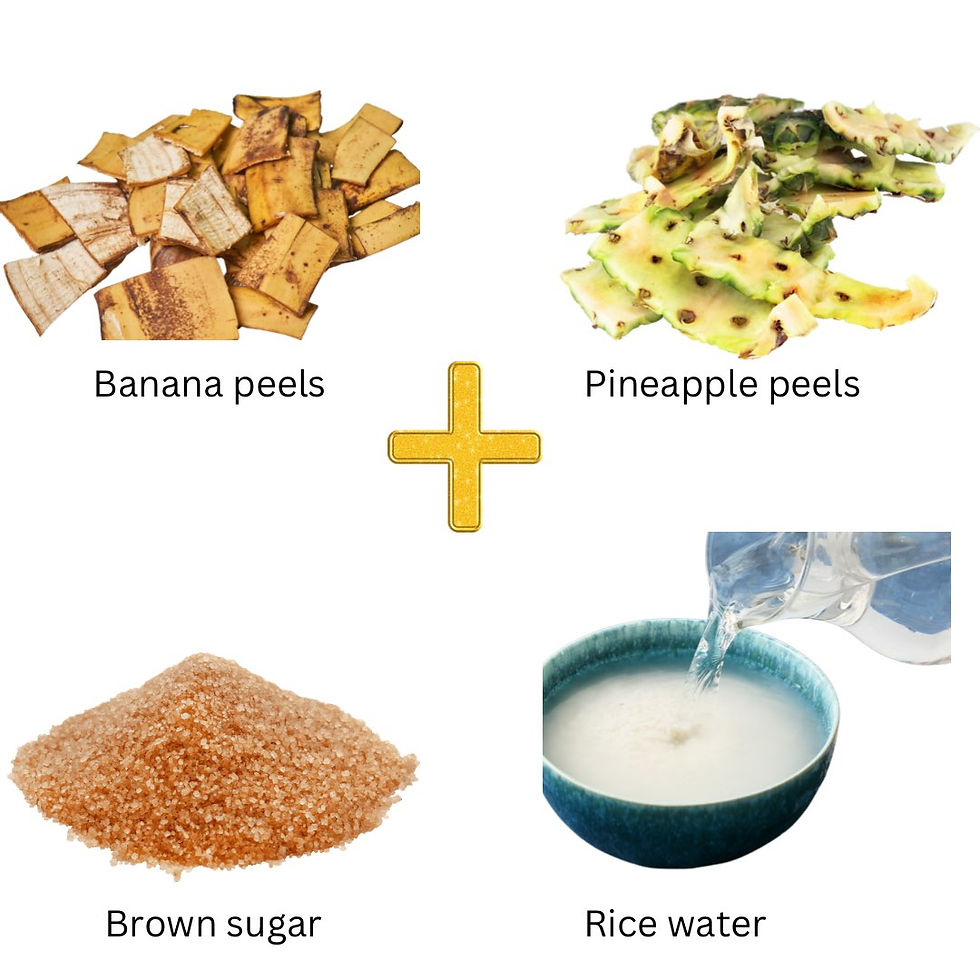How to Make liquid Organic Fertilizer From Pineapple and Banana Peels
- Kantanka Farms
- Oct 31, 2023
- 3 min read
Updated: Nov 17, 2023
Pineapple and banana fruits, known for their nutritional value and delectable taste, often leave us with the question of what to do with the discarded peels after indulging in the fruit. Typically, these peels are cast aside, contributing to insect breeding and environmental pollution. In fact, there have been instances, such as a man slipping in Accra after accidentally stepping on a improperly disposed banana peel.
Did you realize that you can repurpose pineapple and banana peel waste to create a beneficial liquid organic fertilizer? This article will guide you through the process of turning pineapple and banana peels into organic liquid fertilizer. Liquid fertilizer stands out due to its ease of production and application—it readily dissolves in the soil, facilitating swift absorption by plant roots. Additionally, liquid fertilizer ensures a more uniform distribution, preventing the concentration of fertilizer in specific areas.
MATERIALS AND METHODOLOGY

Materials
Banana peels
Pineapple peels
Natural Bacteria Starters
How to make Natural bacteria starter
Measure 40 grams of pineapple peels and 40 grams of banana peels
Add 74 grams of brown sugar and 74 ml of rice water,
Mash them with a blender
Pour the mixture in a bottle, close tightly and leave unopened for 15 days.
Making Liquid Organic Fertilizer

Having successfully prepared the natural bacteria starter, it's now time to integrate it with the banana and pineapple peels. Follow these steps meticulously:
1. Measure out 100 grams of pineapple peels and 100 grams of banana peels.
2. Introduce 400ml of water into the mixture.
3. Incorporate 20ml of the natural bacteria starter.
4. Utilize a blender to mash the ingredients thoroughly.
5. Securely cover the mixture in a fermenter bottle and allow it to ferment for a duration of 21 days.
How to Use 'Banapple' Organic fertilizer
Our newly created liquid organic fertilizer is now ready for use, and from now on, we'll refer to it as 'banapple organic fertilizer' for simplicity. So, how do we effectively apply it? To understand its application, it's essential to grasp the significance of NPK ratios.
Plants require a variety of minerals and nutrients to thrive, with three major nutrients standing out: Nitrogen (N), Phosphorus (P), and Potassium (K). Nitrogen supports lush, green leafy growth, while Phosphorus is crucial for developing healthy roots and shoots. Potassium, on the other hand, stimulates the growth of flowers and fruits.
Through testing and research conducted by experts in the field of agriculture, banapple organic fertilizer has been proven to contain all three major nutrients along with some micronutrients. However, it was observed that the ratios of Phosphorus (P) and Potassium (K) in banapple organic fertilizer were notably higher. This implies that it serves as an excellent supplement for promoting root, flower, and fruit development. Consequently, it can be applied to plants from the seedling stage through fruit formation.
It's important to note that leafy vegetables like lettuce, spinach, kale, cabbage, and Swiss chard don't require as much banapple fertilizer since they do not produce fruits. Excessive application of banapple organic fertilizer to such leafy vegetables may cause them to bolt and go to seed prematurely. For these types of vegetables, a more suitable organic fertilizer alternative would be the highly nitrogenous weed tea fertilizer, which is easy to make. Further details can be found in our guide here.
Application of Organic fertilizer

Leafy vegetables :
Combine 80ml of banapple organic fertilizer with 500ml of weed tea organic fertilizer. Mix this concentrate with 12 liters of water and administer the solution to the roots of your leafy plants. Repeat this application every two weeks. However, if your plants are situated in organic soil enriched with organic matter, it is recommended to extend the application interval to every 3 to 4 weeks.
For vegetables such as tomatoes, eggplant, sweet pepper, cucumber, etc., increase the proportion of banapple organic fertilizer once they commence flower development. Follow the same procedure as outlined earlier. When your plants enter the flowering stage, exclusively use the banapple fertilizer. During this phase, plants shift their focus from leaf production to channeling energy into flower and fruit development. Mix 300ml of banapple organic fertilizer with 12L of water and apply the solution to the roots of your plants. This application should be repeated every 2 to 3 weeks.
Conclusion
Using organic fertilizer in the garden offers numerous benefits. These fertilizers replenish the nutrients depleted by growing plants, promoting the health of your garden soil. Additionally, organic materials enhance soil texture, enabling it to retain water for extended periods, while also fostering increased bacterial and fungal activity. In essence, organic fertilizers not only support plant growth but also contribute to overall soil health.
In contrast, synthetic fertilizers tend to deplete the soil of its essential nutrients, rendering it less productive over time. Taking the initiative to create your own banapple and weed tea organic fertilizers can lead to a greener and healthier garden. Feel free to share your results and opinions in the comment section.

.png)
Comments